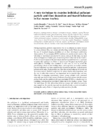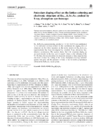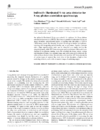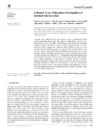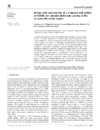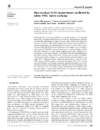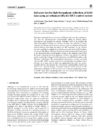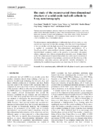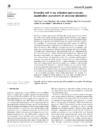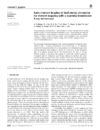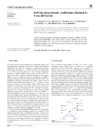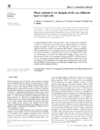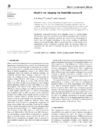issue contents
November 2010 issue

Cover illustration: Dual-energy contrast STXM images of a human cervical carcinoma cell scanned at the Fe L-edge: 703.1 eV and 706.3 eV (see Zhang, Xu, Tai, Zhen, Wang, Guo, Yan, Chang, Wang, Li, Zhao and Gao, pages 804-809). The coloured areas indicate the existence of ferroferric oxide within the cell, and the colour bar reflects its relative concentration. The right-hand image resulted from the conventional subtraction-contrast method, while the left-hand image resulted from the new ratio-contrast method. It is easily seen that some pseudo information on the ferroferric oxide distribution has been eliminated using the new method as indicated by the ellipses.
facility information
research papers
Diamond-based beam monitors have been demonstrated to have a linear response with respect to incident X-ray flux over eleven orders of magnitude. Position and temporal sensitivity are reported.
Open  access
access
 access
accessThis experiment established synchrotron phase-contrast X-ray imaging techniques to non-invasively examine pollutant particulate deposition and mucociliary transit in live mouse trachea. In this report the behaviour of individual particles of quarry dust, fibreglass, lead ore and reference hollow silver-coated glass beads was examined in live and intact animals.
The potassium doping effect on the lattice softening and electronic structure of Ba1–xKxFe2As2 has been investigated by Fe and As K-edge X-ray absorption spectroscopy.
Open  access
access
 access
accessAn indirectly illuminated X-ray area detector employed for X-ray photon correlation spectroscopy is discussed.
Open  access
access
 access
accessRadiation damage propagation was examined in starch granules by synchrotron radiation micro- and nano-diffraction techniques from cryo- to room temperatures. Careful dose limitation allowed raster-diffraction experiments with 500 nm step resolution to be performed.
Pseudo-merohedrally twinned manganite microcrystals have been studied by coherent diffraction. Several diffraction peaks were split, as expected from the twin law. Furthermore, the peaks were broken up into fringes and speckles. This method represents a new way of measuring twin domains and could allow mapping out twin and strain distributions within microcrystals.
A synchrotron radiation circular dichroism end-station with a usable wavelength region of 130–330 nm is implemented at beamline BL04B at NSRRC in Taiwan for biological research.
A simple method for collecting time-resolved small-angle X-ray scattering data is presented. A combination of SAXS and online HPLC enables data collection from systems where a reaction is triggered by removal of a species or a change in buffer conditions.
Open  access
access
 access
accessThe Blu-Ice GUI and Distributed Control System (DCS) developed in the Macromolecular Crystallography Group at the Stanford Synchrotron Radiation Laboratory has been optimized, extended and enhanced to suit the specific needs of the SAXS endstation at the SIBYLS beamline at the Advanced Light Source. The customizations reported here provide one potential route for other SAXS beamlines in need of robust and efficient beamline control software.
The high-resolution X-ray nanotomography technique is applied to reconstruct the three-dimensional microstructure of a solid-oxide fuel-cell cathode. Some key parameters are calculated based on the reconstructed data.
Open  access
access
 access
accessBeam-induced damage on diffractive hard X-ray optics is studied by means of X-ray diffraction and scanning electron microscopy.
The quantitative evaluation of X-ray emission is extended to the soft X-ray regime (100–1500 eV). Available absorption coefficients are verified and thin film thicknesses of layered polycrystalline model systems determined. A scanning procedure is presented that is able to resolve lateral inhomogeneities.
A variable-wavelength-based approach of phase retrieval for contrast transfer function based methods
Application of a multi-wavelength approach for phase retrieval within the framework of the contrast transfer function based formalism is discussed.
The detection of chemical mapping with a spatial resolution of 30 nm has been achieved with a scanning transmission X-ray microscope at the Shanghai Synchrotron Radiation Facility.
short communications
Crystals of pure potassium dihydrogen phosphate (KDP) and Mn-doped KDP were grown from a water solution by the slow evaporation method and their piezoelectric properties were studied by X-ray diffraction methods.
Carbon-paper gas diffusion layers of fuel cells imaged via X-ray interferometric and diffraction-enhanced imaging techniques have proven that these phase-contrast X-ray imaging techniques are valuable for their tomographic imaging and in situ observations of the transport and distribution of water within.
A hard X-ray imaging approach enables us to track granular displacements and helps to understand how underwater landslides break out and evolve.
current events
Free 



 journal menu
journal menu






















